RETRACTED: Reconstructing the Dynamic Processes of the Taimali Landslide in Taiwan Using the Waveform Inversion Method
Abstract
:1. Introduction
2. Review of Waveform Inversion Methods for Reconstructing the Dynamic Processes of a Landslide
3. Study Case and Method
3.1. Taimali Landslide
3.2. Seismic Data Processing
3.3. Point Force History Inversion
- (1)
- ZVF: vertical component for a downward vertical force,
- (2)
- RVF: radial component for a downward vertical force,
- (3)
- ZHF: vertical component for a horizontal force in the radial direction,
- (4)
- RHF: radial component for a horizontal force in the radial direction, and
- (5)
- THF: tangential component for a horizontal force in the transverse direction.
4. Results and Discussion
4.1. Results of PFH Inversion
4.2. Dynamic Processes Determined by PFH Inversion
4.3. The Requirement for the Single-Station Inversion
5. Conclusions
Author Contributions
Funding
Acknowledgments
Conflicts of Interest
References
- Huang, S.W.; Jean, J.S.; Hu, J.C. Huge rock eruption caused by the 1999 Chi-Chi earthquake in Taiwan. Geophys. Res. Lett. 2003, 30, 1858. [Google Scholar] [CrossRef]
- Yu, F.C.; Chen, L.K. Discussion on slope disasters triggered by Typhoon Morakot. J. Civil Hydraul. Eng. 2010, 37, 32–40. (In Chinese) [Google Scholar]
- Council of Agriculture. Typhoon Morakot: An overview of agriculture loss. In Agriculture Policies and Circumstances; Council of Agriculture, Executive Yuan: Taipei, Taiwan, 2009; p. 207. (In Chinese) [Google Scholar]
- Chigira, M. The Potential Area of Large-Scale Landslides; Scientific & Technical Publishing Co., Ltd.: Taipei, Taiwan, 2011. (In Chinese) [Google Scholar]
- Hibert, C.; Ekström, G.; Stark, C.P. Dynamics of the Bingham Canyon Mine landslides from seismic signal analysis. Geophys. Res. Lett. 2014, 41, 4535–4541. [Google Scholar] [CrossRef]
- Brodsky, E.E.; Gordeev, E.; Kanamori, H. Landslide basal friction as measured by seismic waves. Geophys. Res. Lett. 2003, 30, 2236. [Google Scholar] [CrossRef]
- Ekström, G.; Stark, C.P. Simple scaling of catastrophic landslide dynamics. Science 2013, 339, 1416–1419. [Google Scholar] [CrossRef] [PubMed]
- Lin, C.H.; Jan, J.C.; Pu, H.C.; Tu, Y.; Chen, C.C.; Wu, Y.M. Landslide seismic magnitude. Earth Planet. Sci Lett. 2015, 429, 122–127. [Google Scholar] [CrossRef]
- Fan, X.; Scaringi, G.; Dai, L.; Li, W.; Dong, X.; Zhu, X.; Pei, X.; Dai, K.; Havenith, H. Failure mechanism and kinematics of the deadly June 24th 2017 Xinmo landslide, Maoxian, Sichuan, China. Landslides 2017, 14, 2129–2146. [Google Scholar] [CrossRef]
- Kanamori, H.; Given, J.W. Analysis of long-period seismic waves excited by the May 18, 1980, eruption of Mount St. Helens—A terrestrial monopole? J. Geophys. Res. Solid Earth 1982, 87, 5422–5432. [Google Scholar] [CrossRef]
- Kanamori, H.; Given, J.W.; Lay, T. Analysis of seismic body waves excited by the Mount St. Helens eruption of May 18, 1980. J. Geophys. Res. Solid Earth 1984, 89, 1856–1866. [Google Scholar] [CrossRef]
- Nakano, M.; Kumagai, H.; Inoue, H. Waveform inversion in the frequency domain for the simultaneous determination of earthquake source mechanism and moment function. Geophys. J. Int. 2018, 173, 1000–1011. [Google Scholar] [CrossRef]
- Lin, C.H.; Kumagai, H.; Ando, M.; Shin, T.C. Detection of landslides and submarine slumps using broadband seismic networks. Geophys. Res. Lett. 2010, 37, L22309. [Google Scholar] [CrossRef]
- Yamada, M.; Kumagai, H.; Matsushi, Y.; Matsuzawa, T. Dynamic landslide processes revealed by broadband seismic records. Geophys. Res. Lett. 2013, 40, 2998–3002. [Google Scholar] [CrossRef]
- Hibert, C.; Stark, C.P.; Ekström, G. Dynamics of the Oso-Steelhead landslide from broadband seismic analysis. Nat. Hazards Earth Syst. Sci. 2015, 15, 1265–1273. [Google Scholar] [CrossRef]
- Chao, W.A.; Zhao, L.; Chen, S.C.; Wu, Y.M.; Chen, C.H.; Huang, H.H. Seismology-based early identification of dam-formation landquake events. Sci. Rep. 2016, 6, 19259. [Google Scholar] [CrossRef] [PubMed]
- Allstadt, K. Extracting source characteristics and dynamics of the August 2010 Mount Meager landslide from broadband seismograms. J. Geophys. Res. Earth Surf. 2013, 118, 1472–1490. [Google Scholar] [CrossRef]
- Iverson, R.M.; George, D.L.; Allstadt, K.; Reid, M.E.; Collins, B.D.; Vallance, J.W.; Schilling, S.P.; Godt, J.W.; Cannon, C.M.; Magirl, C.S.; et al. Landslide mobility and hazards: Implications of the 2014 Oso disaster. Earth Planet. Sci. Lett. 2015, 412, 197–208. [Google Scholar] [CrossRef]
- Kuo, H.L. A Study of Landslide-Triggering Rainfall Conditions by Analyzing the Ground Motion Signals Induced by Large-Scale Landslides. Master’s Thesis, National Cheng Kung University, Tainan, Taiwan, 2016; 139p. (In Chinese). [Google Scholar]
- Wang, Y.C.; Chen, W.F. Study on Damages Analysis and Improvement Programs of Flood Control Structures Caused by Compound Disasters after Typhoon Morokot—Taimali River as an Example. In Chinese Soil and Water Conservation Society Conference and Academic Seminar Abstracts; Chinese Soil and Water Conservation Society: Taipei, Taiwan, 2012; 16p. [Google Scholar]
- Ho, C.S. An introduction to The Geology of Taiwan Explanatory Text of The Geologic Map of Taiwan; Central Geological Survey: Taipei, Taiwan, 1994. (In Chinese)
- IES. Broadband Array in Taiwan for Seismology; Other/Seismic Network; Institute of Earth Sciences, Academia Sinica: Taipei, Taiwan, 1996. [Google Scholar] [CrossRef]
- Eissler, H.K.; Kanamori, H. A single-force model for the 1975 Kalapana, Hawaii, earthquake. J. Geophys. Res. Solid Earth 1987, 92, 4827–4836. [Google Scholar] [CrossRef]
- Herrmann, R.B. Computer Programs in Seismology: An Overview of Synthetic Seismogram Computation; Saint-Louis University: St. Louis, MO, USA, 2002. [Google Scholar]
- Chen, Y.L.; Shin, T.C. Study on the earthquake location of 3-D velocity structure in the Taiwan area. Meteorol. Bull. 1998, 42, 135–169. [Google Scholar]
- Pan, Y.W.; Su, H.K.; Liao, J.J.; Huang, M.W. Reconstruction of rainfall-induced landslide dam by numerical simulation-the Barrier Lake in Taimali River as an example. In Rock Mechanics for Global Issues, Proceedings of the ISRM International Symposium-8th Asian Rock Mechanics Symposium, Sapporo, Japan, 14–16 October 2014; International Society for Rock Mechanics and Rock Engineering: Lisbon, Portugal, 2014. [Google Scholar]
- Huang, C.M. Combination of Three-Dimensional Discrete Element Method and Geological Model to Simulate the Migration of Taimali Landslide, Xinmo Landslide and Shezailiao Landslide-Prone Slope. Master’s Thesis, National Cheng Kung University, Tainan, Taiwan, 2019. (In Chinese). [Google Scholar]


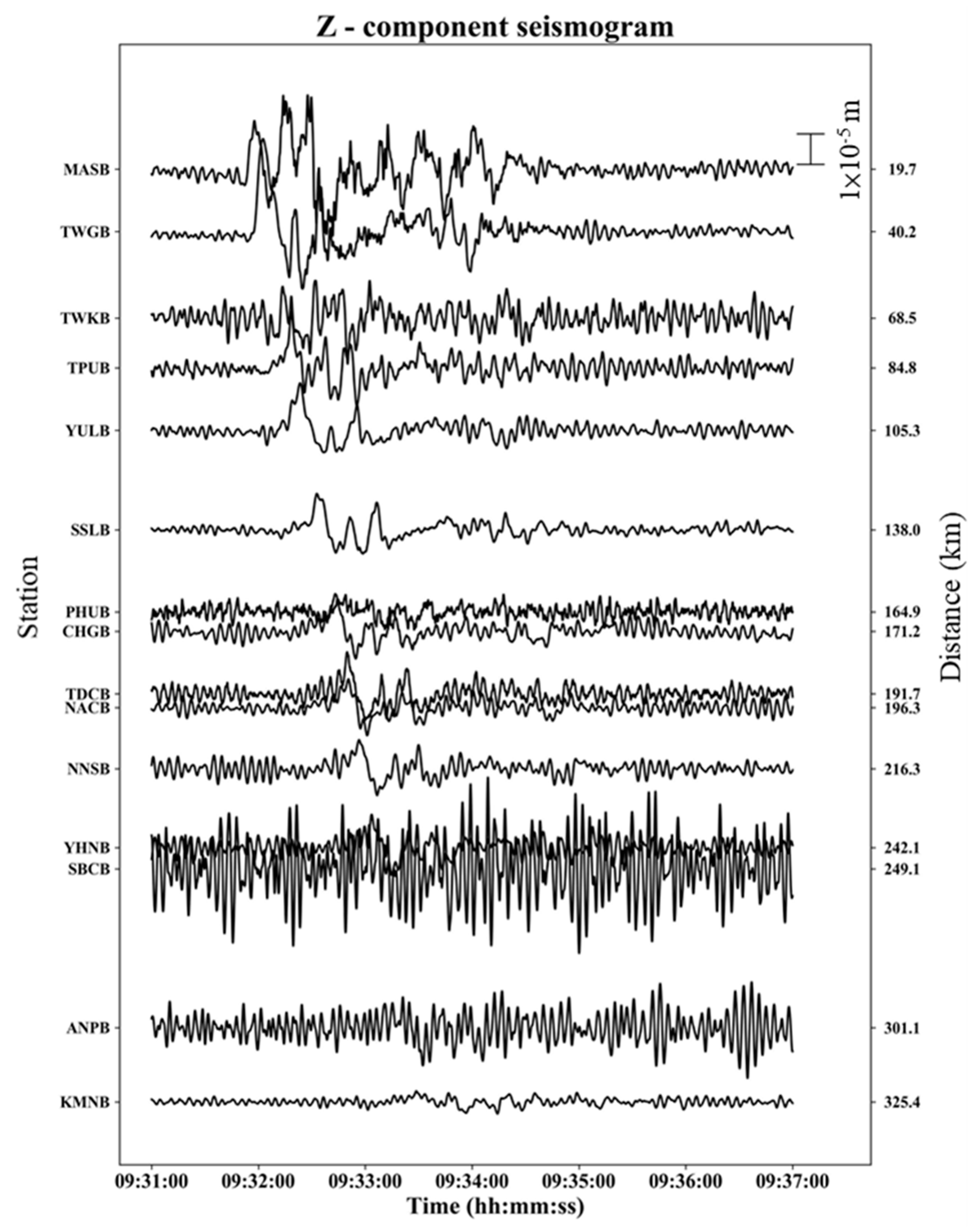
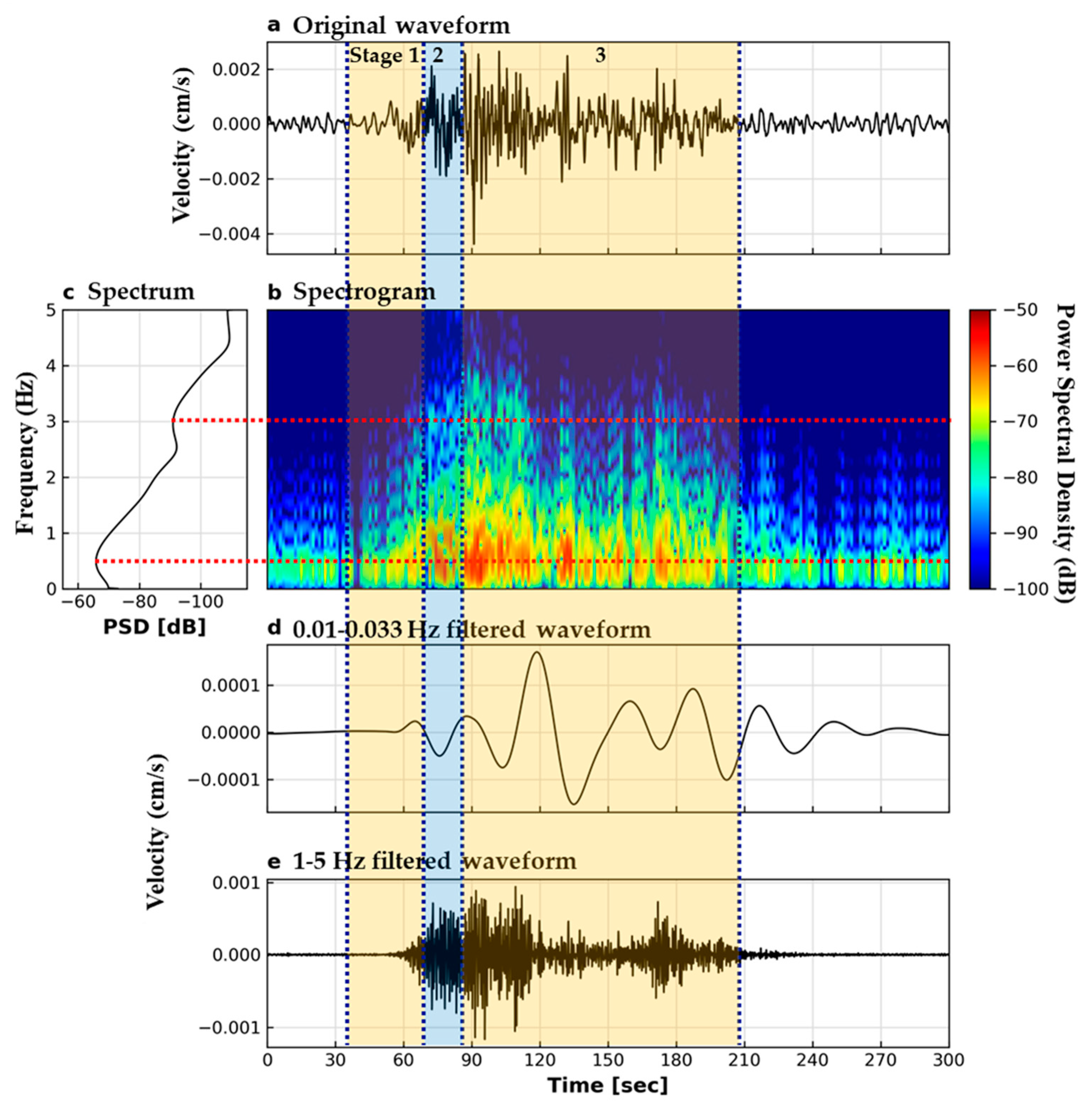

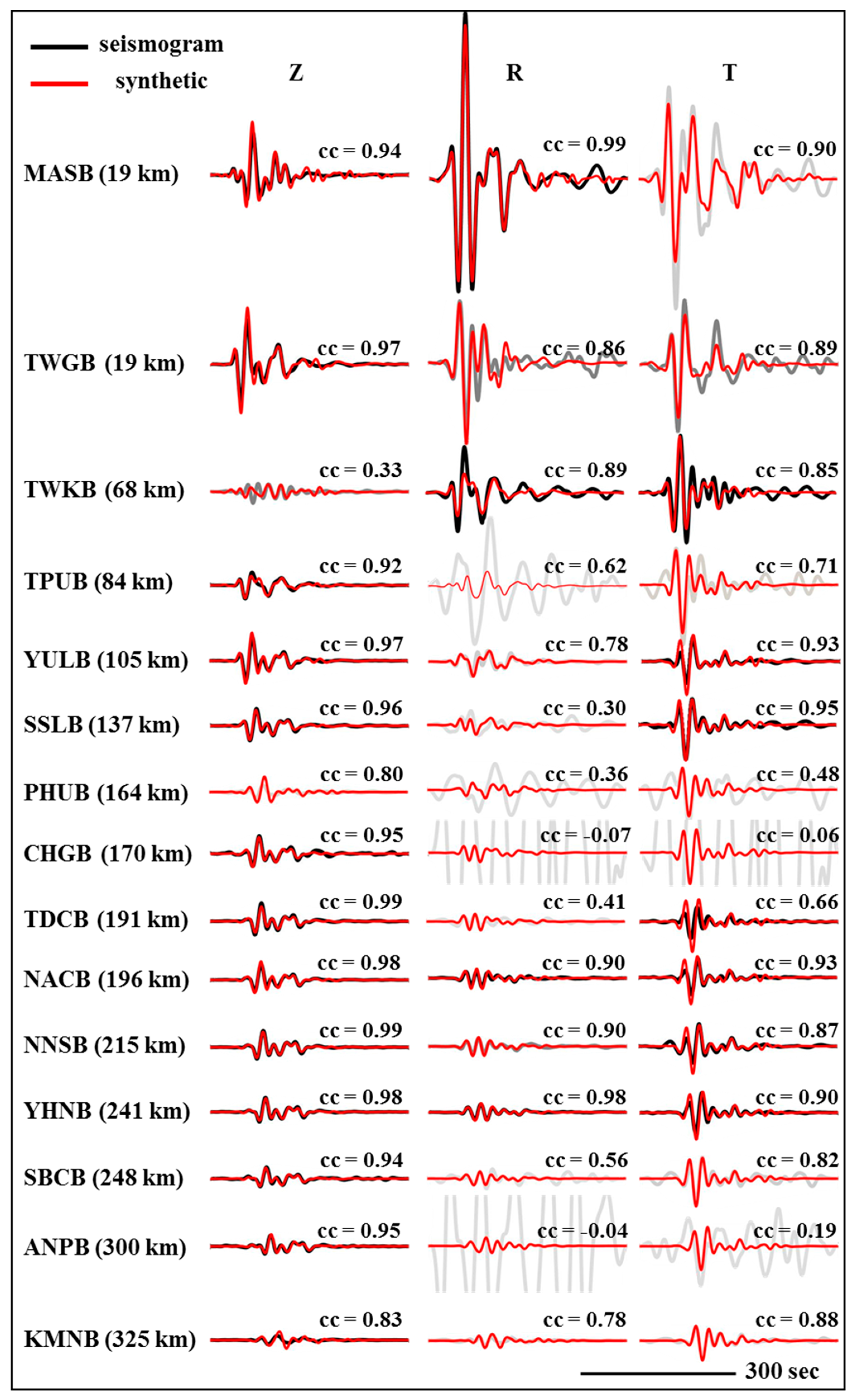
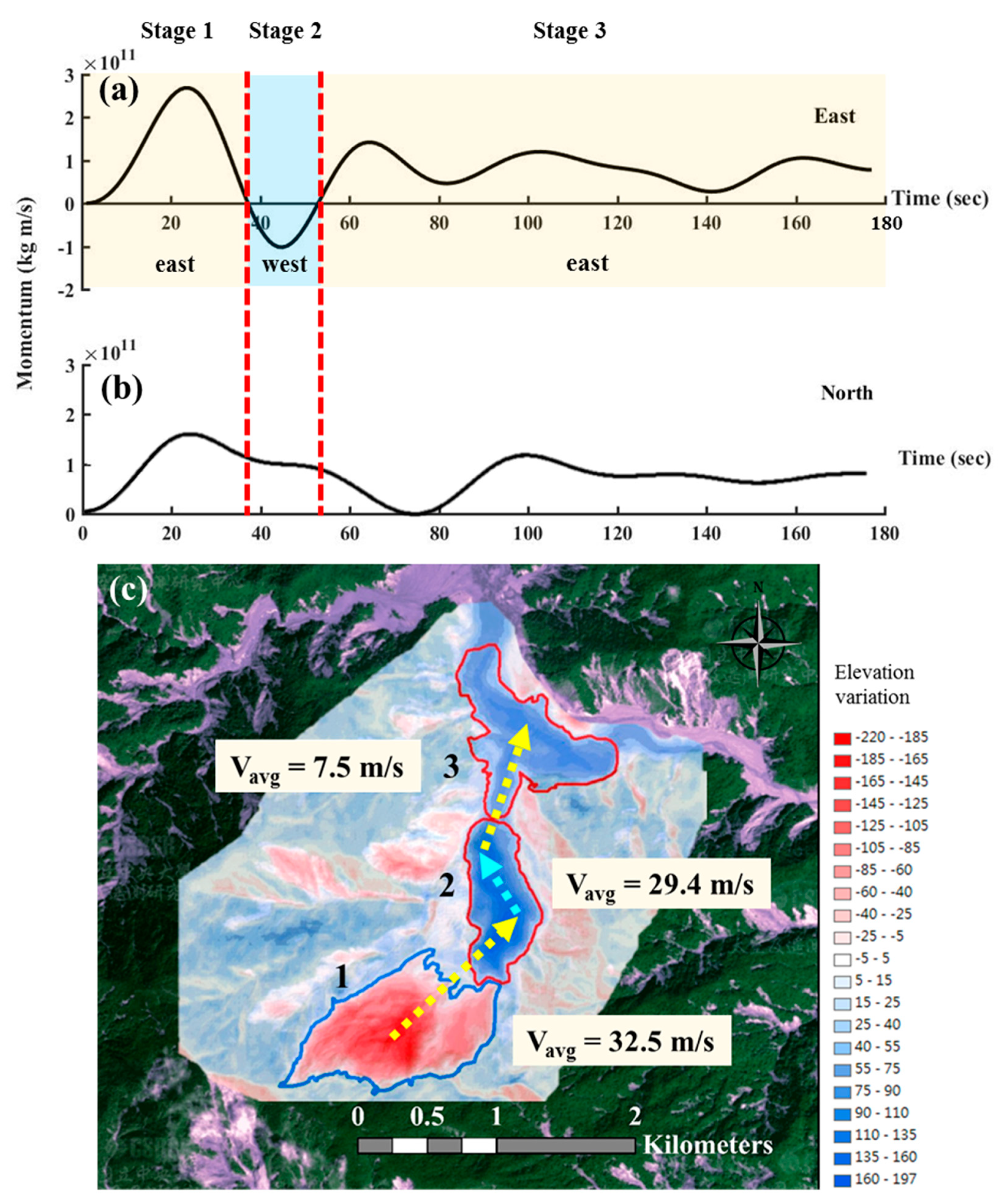
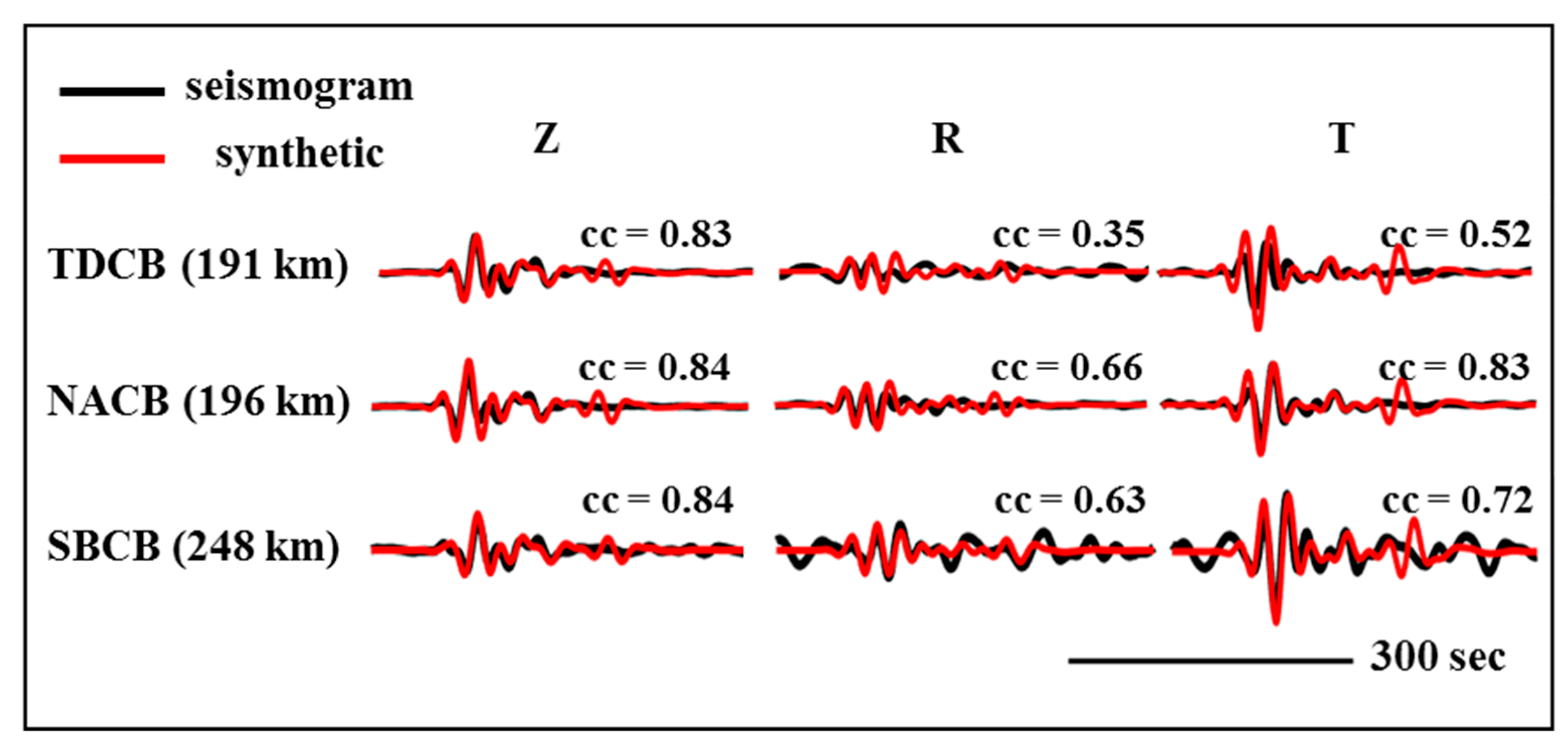
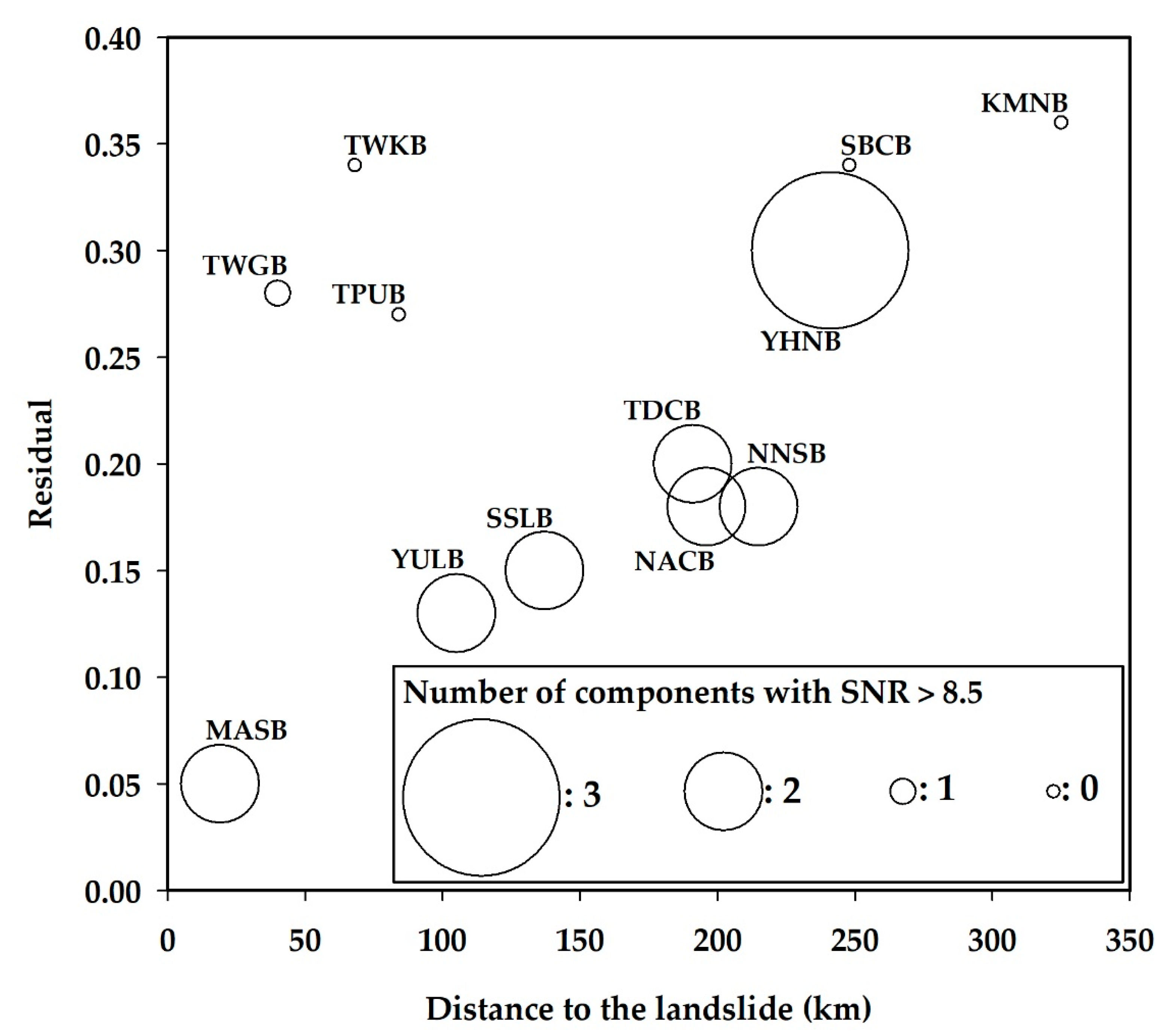
| Zone | Area (106 m2) | Maximum Thickness (m) | Average Thickness (m) | Volume (106 m3) | Estimated Mass (106 kg) |
|---|---|---|---|---|---|
| 1 | 0.93 | 219.7 | 80.9 | 75 | 20 |
| 2 | 1.24 | 196.9 | 96.9 | 45 | 12 |
| 3 | 1.22 | 110.6 | 67.2 | 43 | 12 |
| SNR Value | Weighting Coefficient |
|---|---|
| >8.5 | 1 |
| 7.5–8.5 | 0.8 |
| 6.5–7.5 | 0.6 |
| 5.5–6.5 | 0.4 |
| <5.5 | 0 |
| Stage | Duration (s) | Runout Distance (m) | Average Velocity (m/s) |
|---|---|---|---|
| 1 | 37 | 1200 | 32.5 |
| 2 | 17 | 500 | 29.4 |
| 3 | 120 | 900 | 7.5 |
| Station | Distance (km) | R-SNR | T-SNR | Z-SNR | Residual |
|---|---|---|---|---|---|
| MASB | 19 | 9.2 | 6.2 | 11.3 | 0.05 |
| TWGB | 40 | 7.3 | 6.5 | 9.5 | 0.28 * |
| TWKB | 68 | 7 | 8.2 | 7.2 | 0.34 * |
| TPUB | 84 | 3.9 # | 7.3 | 7.4 | 0.27 * |
| YULB | 105 | 6.8 | 10.5 | 10.4 | 0.13 |
| SSLB | 137 | 4.0 # | 9 | 9.2 | 0.15 |
| TDCB | 191 | 3.3 # | 9.9 | 10 | 0.20 |
| NACB | 196 | 7.6 | 11 | 10.4 | 0.18 |
| NNSB | 215 | 6.2 | 8.9 | 10.6 | 0.18 |
| YHNB | 241 | 7.7 | 10.2 | 10.3 | 0.30 * |
| SBCB | 248 | 3.9 # | 5.8 | 8.3 | 0.34 * |
| KMNB | 325 | 6.7 | 7 | 6.7 | 0.36 * |
© 2020 by the authors. Licensee MDPI, Basel, Switzerland. This article is an open access article distributed under the terms and conditions of the Creative Commons Attribution (CC BY) license (http://creativecommons.org/licenses/by/4.0/).
Share and Cite
Lin, G.-W.; Hung, C. RETRACTED: Reconstructing the Dynamic Processes of the Taimali Landslide in Taiwan Using the Waveform Inversion Method. Appl. Sci. 2020, 10, 5872. https://doi.org/10.3390/app10175872
Lin G-W, Hung C. RETRACTED: Reconstructing the Dynamic Processes of the Taimali Landslide in Taiwan Using the Waveform Inversion Method. Applied Sciences. 2020; 10(17):5872. https://doi.org/10.3390/app10175872
Chicago/Turabian StyleLin, Guan-Wei, and Ching Hung. 2020. "RETRACTED: Reconstructing the Dynamic Processes of the Taimali Landslide in Taiwan Using the Waveform Inversion Method" Applied Sciences 10, no. 17: 5872. https://doi.org/10.3390/app10175872






